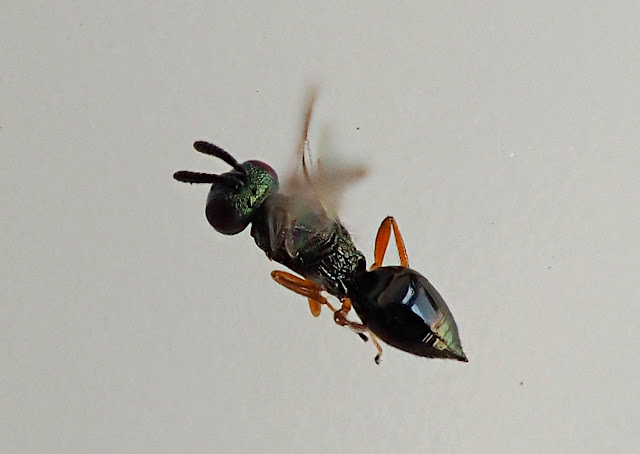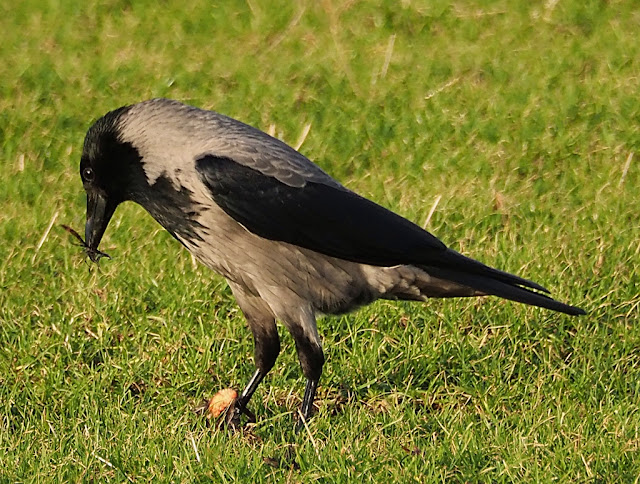We've been getting a lot of weather. More than usual. There was all that snow. Then there was gloom and wind. A couple of really lovely days, and now we're back to the wind. This afternoon I struggled to make headway against the wind, it must have been 40mph and gusting 50. More than 50 will likely blow me over. An indoors day spent photographing and identifying things collected over the last week or so, there are still quite a few to do.
I do like the genus Stenus. They are Staphylinidae and fairly tricky to identify, they are quite small also. To my eye they look like wee aliens. I took a clump of Cock'sfoot, Dactylis glomerata, the other day and pulled it apart in a plastic tub. There were a few Stenus in there, it looked like three different species. Not unexpected was Stenus clavicornis, a largish one at 5.0mm. Like many Staphs the way to be sure of your ID is to dissect out the male genitalia. That can be a bit of a challenge with small beetles like these but I've developed a bit of a technique. After photographing the whole animal I chop off the tip of the abdomen and put it into glycerine. In glycerine it is possible to manipulate and pull apart the abdomen with a couple of setting pins, ideally ones that a a bit bent over at the tip. With a bit of care, and with the glycerine preventing the specimen part being pinged across the room, it is usually possible to get the male bits out.
 |
| Stenus clavicornis male genitalia, macro image, cropped. |
 |
| Stenus clavicornis, male. |
With really small things like genitalia I can photograph them down the microscope, by holding the camera to an eyepiece, but the results are usually better using the camera with the 30mm macro and then cropping the image.
With this Stenus ossium, proven with the genitalia, I photographed the dissection down the microscope, but the image is not as clear, although good enough to prove the ID.
Stenus ossium has been recorded in Orkney once before, although not on the NBN. However, I recorded it last year as well I think, but I didn't dissect it on that occasion.
 |
| Stenus ossium, male genitalia, microscope image. |
 |
| Stenus ossium, male, 3.5mm. |
Stenus latifrons is supposedly rare in Scotland, again there is a previous record for the county. Both the collected specimens on this occasion were female, so no dissection proof. But it keyed out fairly easily, so I'm confident.
 |
| Stenus latifrons |
The most intriguing thing in the Cock'sfoot sample was this 2.2mm long parasitic wasp. I should have recognised it, but I didn't, fortunately PV again helped me by telling me the genus. Last year PV helped me with a similar wee beast, Cyrtogaster vulgaris, but this time he thought I had something different. I downloaded a book on the family, and then found a I had a key to the genus already. PV had suggested this one might be C. clavicornis (coincidentally the same specific name as one of the Stenus). And with a bit of careful manipulation of the specimen and observation I eventually found the three criteria which seemed to prove this identification.
There's always a bit of doubt with these things using an old key and with a family that is fairly regularly subject to the finding of new species and genera and taxonomic changes, but for now it will be recorded as Crytogaster clavicornis.
It's not hard to spend a whole day trying to identify an animal like this. With beetles the keys are usually pretty good, and folk are producing new ones, improving keys at a fairly regular rate. And on the whole the taxonomy is stable and there are not many "new to science" species popping up. With Hymenoptera, and especially with Chalcidae, and this family, Pteromalidae everything is in flux, the keys may be unreliable, or not include all the species. With a bit of determination and a pocket bar-coding kit I suspect finding a species new to science would be possible pretty much anywhere. It's easy to get drawn in to spending a lot of time and then still not getting an ID with these though. I found an Ichneumon the other day from the genus Gelis (probably). These are very, very difficult and I should just leave it as Gelis sp; but I've already spent a bit of time asking for help and looking at keys. With a fridge full of last year's Ichneumons still to look at I should just leave the Gelis be.
 |
| Gelis sp, wingless (apterous) female, best leave it at that... |
Not much on the bird front although there were two Shelduck sightings in January, and four Coot on The Shunan on Tuesday, the earliest of both in 14 years. The Great White Egret(s) seem to have disappeared and nothing much else going on, a couple of Woodcock sightings being the highlight. Redwings and Fieldfares have pretty much disappeared since the snow. I should deploy the camera trap to see if there's a Water Rail about. Hoodies and Ravens are sorting out territories and nest sites, and the Rooks are eyeing the rookery on fine days.
 |
| Hooded Crow with something dead. |
 |
| Just a very few nests have survived the winter. |
The grass clump from the Wee Wood had a few other beasts within, best of which was this Tachporus obtusus, another Staphy, quite a smart one.
 |
| Tachyporus obtusus. |
There were a couple of Micrambe ulicis in the grass as well, a bit of a way from the Gorse. A single Trichoiscus pusillus, a very small, but very common woodlouse was also in there.
In amongst my vegetation collecting were some samples of moss and lichen from the Hawthorn hedge. There were a few collembola in there, yet to be examined, a egg or two in the moss Ulota phyllantha, and on the bare wood, what I thought was a lichen but is a fungi (thanks BH), Lachnella alboviolascens maybe.
 |
| Lachnella alboviolascens maybe. |
I've just received another suggestion for this one of Lachnum bicolor, so I'll follow that up.
Rabbit photos, the Rabbits were "hiding" from us under this piece of Gorse which had been blown into the field.
 |
| Rabbit. |
Now follows various scenic pix.
 |
| Scene at Marwick, taken with my "new" Pixel 7. |
I decided to upgrade my phone. A tad extravagant but I wanted something with a decent camera in it. I had a look around on various websites, but in the end found idoodirect on eBay who seem to have a good reliability score, they answer any criticism, and with eBay there is that bit of added protection, especially for the buyer.
The phone that arrived is like new, battery good etc etc. And the camera has lived up to expectations. So pleased that Louise decided to upgrade her iPhone SE, the iPhone 12 that arrived is also just like new. The cost a fraction of new phones, thus the recommendation above.
I've been playing around with the Pixel camera quite a bit, I find it a bit strange to use, as I'm used to a "real" camera, holding it still is not so easy, but the results are getting better.
 |
| Waves a bit burnt out here. |
 |
| Once the snow melted there are many Orkney Vole runs visible. |
 |
| The Old Man from Marwick, with a proper camera - E-M1 Mk11 with Oly 75-300mm. |













No comments:
Post a Comment